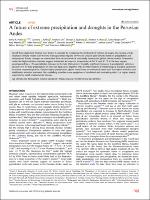| dc.contributor.author | Potter, Emily R. | |
| dc.contributor.author | Fyffe, Catriona L. | |
| dc.contributor.author | Orr, Andrew | |
| dc.contributor.author | Quincey, Duncan J. | |
| dc.contributor.author | Ross, Andrew N. | |
| dc.contributor.author | Rangecroft, Sally | |
| dc.contributor.author | Medina, Katy | |
| dc.contributor.author | Burns, Helen | |
| dc.contributor.author | Llacza Rodríguez, Alan | |
| dc.contributor.author | Jácome Vergaray, Gerardo | |
| dc.contributor.author | Hellström, Robert Å. | |
| dc.contributor.author | Castro, Joshua | |
| dc.contributor.author | Cochachin, Alejo | |
| dc.contributor.author | Montoya, Nilton | |
| dc.contributor.author | Loarte, Edwin | |
| dc.contributor.author | Pellicciotti, Francesca | |
| dc.date.accessioned | 2023-08-04T16:33:10Z | |
| dc.date.available | 2023-08-04T16:33:10Z | |
| dc.date.issued | 2023-07-20 | |
| dc.identifier.uri | https://hdl.handle.net/20.500.12542/2865 | |
| dc.description | Esta investigación se realizó en el marco de los proyectos Perú GROWS y PEGASUS | |
| dc.description.abstract | Runoff from glacierised Andean river basins is essential for sustaining the livelihoods of millions of people. By running a high-resolution climate model over the two most glacierised regions of Peru we unravel past climatic trends in precipitation and temperature. Future changes are determined from an ensemble of statistically downscaled global climate models. Projections under the high emissions scenario suggest substantial increases in temperature of 3.6 °C and 4.1 °C in the two regions, accompanied by a 12% precipitation increase by the late 21st century. Crucially, significant increases in precipitation extremes (around 75% for total precipitation on very wet days) occur together with an intensification of meteorological droughts caused by increased evapotranspiration. Despite higher precipitation, glacier mass losses are enhanced under both the highest emission and stabilization emission scenarios. Our modelling provides a new projection of combined and contrasting risks, in a region already experiencing rapid environmental change. | es_PE |
| dc.description.sponsorship | Financiados por NERC y CONCYTEC a través del Fondo Newton-Paulet. | |
| dc.format | application/pdf | es_PE |
| dc.language.iso | spa | es_PE |
| dc.publisher | Servicio Nacional de Meteorología e Hidrología del Perú | es_PE |
| dc.relation.uri | https://www.nature.com/articles/s41612-023-00409-z | es_PE |
| dc.rights | info:eu-repo/semantics/openAccess | es_PE |
| dc.rights | Atribución-NoComercial-SinDerivadas 3.0 Estados Unidos de América | * |
| dc.rights.uri | http://creativecommons.org/licenses/by-nc-nd/3.0/us/ | * |
| dc.source | Repositorio Institucional - SENAMHI | es_PE |
| dc.source | Servicio Nacional de Meteorología e Hidrología del Perú | es_PE |
| dc.subject | Cambio Climático | es_PE |
| dc.subject | Glaciar | es_PE |
| dc.subject | Sequía | es_PE |
| dc.subject | Sequías Meteorológicas | es_PE |
| dc.subject | Andes | es_PE |
| dc.subject | Precipitación | es_PE |
| dc.title | A future of extreme precipitation and droughts in the Peruvian Andes | es_PE |
| dc.type | info:eu-repo/semantics/article | es_PE |
| dc.identifier.doi | https://doi.org/10.1038/s41612-023-00409-z | |
| dc.subject.ocde | https://purl.org/pe-repo/ocde/ford#1.05.11 | es_PE |
| dc.subject.ocde | https://purl.org/pe-repo/ocde/ford#1.05.10 | es_PE |
| dc.publisher.country | PE | es_PE |









